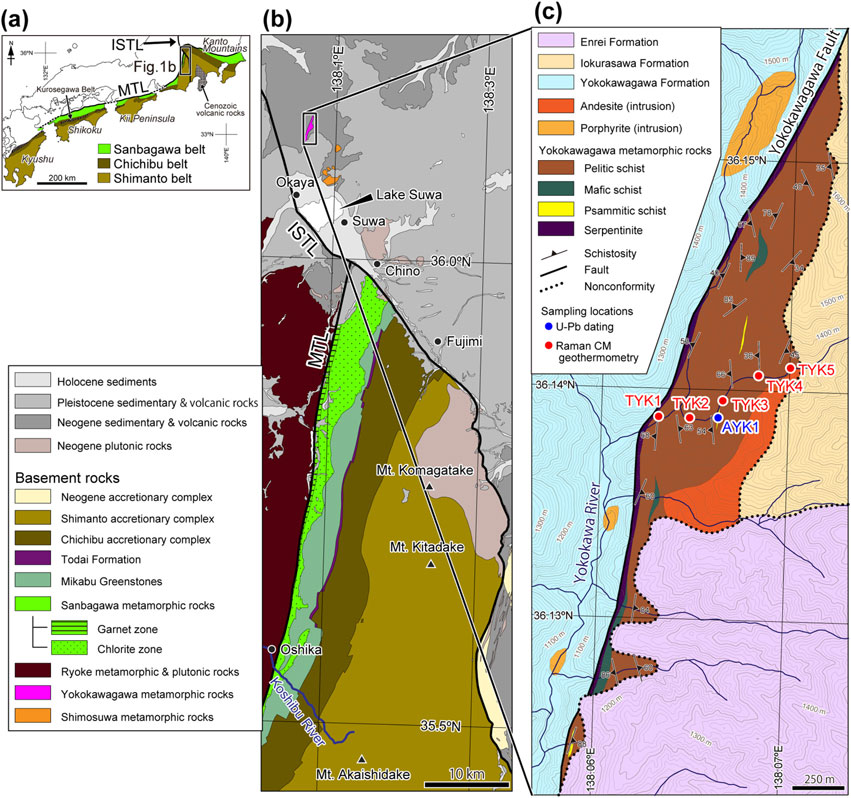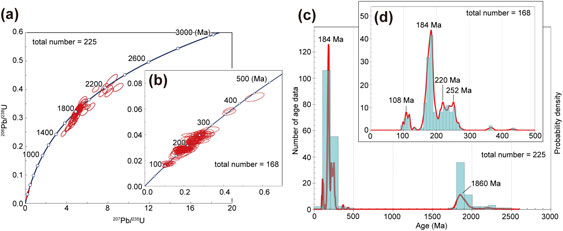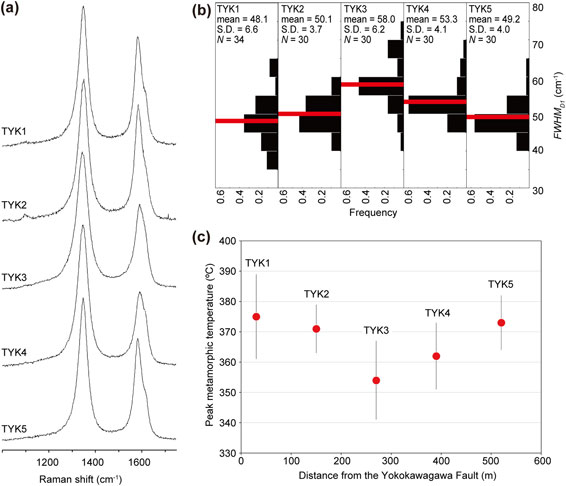2023 年 118 巻 1 号 論文ID: 221215
2023 年 118 巻 1 号 論文ID: 221215
We estimated the protolith age and peak metamorphic temperature of the Yokokawagawa metamorphic rocks (YMR) east of the Itoigawa-Shizuoka Tectonic Line using detrital zircon U-Pb dating and Raman carbonaceous material geothermometry, respectively. U-Pb dating of a psammitic rock yielded a youngest age of ∼ 100 Ma, which corresponds to the protolith age. Raman carbonaceous material geothermometry results for five pelitic rock samples give metamorphic temperatures of ∼ 350-380 °C. The protolith age is consistent with those of the Sanbagawa metamorphic rocks (SMR), strongly indicating that the YMR are an extension of the SMR. The increase in peak temperature toward intrusive rocks along the eastern margin of the YMR may indicate that the relatively young ages yielded by previous K-Ar dating of the YMR reflect thermal resetting due to contact metamorphism.
High-pressure metamorphic rocks that form in subduction zones provide valuable information on plate boundary configurations and processes. Clarification of the regional spatial distributions of lithology, geological structure, and metamorphic grade of these geological bodies is critical to understanding plate boundaries from a geological perspective. The Sanbagawa Belt, which extends more than 800 km from the Kanto Mountains to the Kyushu area along the Median Tectonic Line (MTL) at the northern limit of the Outer Zone of Southwest Japan (Fig. 1a), consists mainly of high-pressure metamorphic rocks (Sanbagawa metamorphic rocks or SMR) that were metamorphosed during the Late Cretaceous. The SMR have been the subject of numerous studies because they record valuable information on the subduction zone at shallow to deep levels of ∼ 15-80 km depth (e.g., Wallis and Okudaira, 2016; Aoya and Endo, 2017 and references therein). The SMR consist mainly of low-grade metamorphic rocks, such as those of the garnet and chlorite zones (e.g., Higashino, 1990). A recent detailed analysis of the thermal structure in this low-grade-metamorphic region of the SMR has shown that it retains valuable original geological structures near the Moho (Kouketsu et al., 2021). Therefore, understanding the lateral extent of geological features in this region is expected to contribute to understanding not only the evolution of the Asian continental margin during the Cretaceous but also the geometry of the seismogenic region in the plate boundary zone. The SMR in the Chubu area, central Japan, also contain low-grade metamorphic rocks. A major fault, the Itoigawa-Shizuoka Tectonic Line (ISTL), cuts the basement rocks of the Outer Zone of Southwest Japan (Fig. 1b). In addition, the basement rocks east of the ISTL are widely covered by Neogene and younger strata (e.g., Nakano et al., 1998; Ozaki et al., 2002; Fig. 1b). Consequently, it is difficult to trace the lateral extension of the basement rocks of the Outer Zone of Southwest Japan east of the ISTL.

The Yokokawagawa metamorphic rocks (YMR) are exposed on a small scale to the north of Lake Suwa (Fig. 1b). Previous studies have suggested that the YMR correspond to the SMR, mainly on the basis of lithological similarity, and that the Yokokawagawa Fault, which marks the western margin of the YMR (Fig. 1c), is an extension of the MTL (e.g., Kawachi et al., 1966; Miyoshi, 1991). In contrast, other studies have argued that the YMR are not an extension of the SMR because the K-Ar ages of the YMR are substantially younger than those of the SMR (Yokoyama, 1992). Therefore, the attribution of the YMR remains unresolved (Enami and Takeuchi, 2006). The solution to this problem is essential not only for the regional lateral extension of the SMR but also for the determination of the northern limit of the Outer Zone of Southwest Japan and the estimation of the total displacement across the ISTL.
In this study, we constrained the protolith age (depositional age) of the YMR using U-Pb dating of detrital zircons and the peak metamorphic temperature for the YMR using Raman carbonaceous material (CM) geothermometry. To determine whether the YMR correspond to a lateral extension of the SMR, we compared the results with equivalent data for the SMR.
The YMR are distributed in Okaya City, Nagano Prefecture, north of Lake Suwa (Figs. 1b and 1c). The western margin of the YMR is bordered by Miocene sedimentary rocks of the Yokokawagawa Formation (e.g., Kumon et al., 1990) across the NNE-SSW trending Yokokawagawa Fault. The northern and eastern margins are nonconformably overlain by Miocene volcanic rocks of the Iokurasawa Formation, and the southern margin by Pliocene-Pleistocene volcanic rocks of the Enrei Formation (younger than ∼ 3 Ma) (e.g., Yoshino, 1976, 1982; Miyoshi, 1991; Kano and Miyasaka, 2020). Andesitic intrusive rocks occur along the boundary between the YMR and the Iokurasawa Formation (Miyoshi, 1991). The YMR are composed mainly of pelitic schist with minor mafic and psammitic schists and serpentinite. The rocks commonly have a well-developed schistosity striking predominantly N-S to NNE-SSW (Fig. 1c and Supplementary Fig. S1; Figs. S1-S2 are available online from https://doi.org/10.2465/jmps.221215).
K-Ar dating of pelitic schists from the eastern margin of the YMR has yielded ages of 28.4-23.7 Ma for whole rocks and 40.5 ± 2.0 Ma for muscovite (Yokoyama, 1992). On the basis of the occurrence of garnet in a very narrow zone (<100 m width) of pelitic schist along the Yokokawagawa Fault, the YMR are divided into garnet and chlorite zones, suggesting an increase in metamorphic grade from east to west (Kawachi et al., 1966; Miyoshi, 1991). Pelitic and mafic schists, which include plagioclase porphyroblasts visible to the naked eye and are termed ‘spotted rocks’, are distributed almost coincidentally with the garnet zone (Miyoshi, 1991; Fig. S1a).
In this study, one psammitic schist sample (AYK1) was collected for U-Pb dating and five pelitic schist samples (TYK1 to TYK5) were collected for Raman CM geothermometry (Fig. 1c). The psammitic schist for U-Pb dating consists mainly of quartz, feldspar, mica, rock fragments, and CM, with the detrital plagioclase being slightly coarser-grained than surrounding minerals (Fig. S1c). The pelitic schists for Raman CM geothermometry comprise predominantly quartz, plagioclase, mica, chlorite, and CM, without garnet (Fig. S1b).
Detrital zircon U-Pb dating analyses were conducted using a laser-ablation-inductively coupled plasma-mass spectrometry (LA-ICP-MS) instrument at Nagoya University, Japan, employing an LA system (NWR213, Electro Scientific Industries) coupled to an MS instrument (Agilent 7700x, Agilent Technologies). Analyses were performed using an ablation pit size of 25 µm, an energy density of 11.7 J/cm2, and a pulse repetition rate of 10 Hz. The detailed procedure for the LA-ICP-MS analyses followed Kouchi et al. (2015). Standard zircon 91500 with a 238U-206Pb age of 1062.4 ± 0.4 Ma (Wiedenbeck et al., 1995) was used for normalization of the National Institute of Standards and Technology standard reference material 610 (Horn and von Blanckenburg, 2007), which was adopted as an external standard for element contents. Data accuracy was monitored by analyzing the Plešovice zircon standard with a 238U-206Pb age of 337.13 ± 0.37 Ma (Sláma et al., 2008). The weighted mean 238U-206Pb age of Plešovice zircon determined during the study was 338.6 ± 4.4 Ma, consistent with the above-published age. In accordance with the assessment of discordance adopted by numerous previous studies (e.g., Cao et al., 2015; Tokiwa et al., 2021), U-Pb zircon ages with a discordance of >10% were excluded from consideration to improve the accuracy of the age data and interpretations. Those U-Pb zircon age data that yielded a U-Pb age ratio (238U-206Pb age/235U-207Pb age, expressed as a percentage) of 90-110% were used as concordant age data (Figs. 2a and 2b). 238U-206Pb ages are given for zircons younger than 1000 Ma and 207Pb-206Pb ages for zircons older than 1000 Ma. All uncertainties are given as 2σ. Ages were calculated in Isoplot/Ex 4.15 (Ludwig, 2012). To determine the youngest detrital zircon age, this study used the weighted mean age of the youngest two or more grains that overlap in age at 1σ (YC1σ), as proposed by Dickinson and Gehrels (2009). We treated this youngest cluster age as the protolith age because the Late Cretaceous youngest cluster age for these detrital zircons from trench-fill deposits in Southwest Japan can be regarded as the protolith age (e.g., Jia and Takeuchi, 2020; Tokiwa et al., 2021).

A total of 225 concordant zircon ages (Fig. 2, Supplementary Table S1; Table S1 is available online from https://doi.org/10.2465/jmps.221215) consist mainly of two age groups: 2500-1700 Ma (26.1%) and 280-90 Ma (72.5%) (Fig. 2c). There is a high percentage of Permian to Jurassic zircons (69.3%), with smaller percentages of Cretaceous (3.2%) and Paleoproterozoic (26.1%) zircons. Zircons in the 280-90 Ma age group are euhedral and display oscillatory zoning (Figs. S2a-S2f). Those in the 2500-1700 Ma age group are rounded and show core-rim or homogeneous textures (Figs. S2g and S2h). The youngest single grain (YSG) age is 97.2 ± 4.8 Ma (Fig. S2a), and the age of the highest peak in the probability density plot is ∼ 184 Ma (Fig. 2d). The youngest cluster consists of two zircon grains, and the YC1σ age is 98.4 ± 3.1 Ma (MSWD = 0.4, n = 2), implying that the protolith age of the YMR is ∼ 100 Ma.
Raman spectral analysis was performed on a thin-section sample polished using 1/4 µm diamond paste, using a Nicolet Almega XR instrument (Thermo Scientific) at Nagoya University. Spectral measurements used a 532 nm Nd-YAG laser focused on carbonaceous particles. The scattered light was detected by a CCD with an electrothermal cooler through a diffraction grating with 2400 diffraction lines per 1 mm. The measurement conditions, selection of CM below the sample surface to be analyzed, number of analyses (>25 points) for each sample, and procedure for peak separation of the obtained Raman spectra of CM followed previous studies (Beyssac et al., 2003; Aoya et al., 2010; Kouketsu et al., 2014, 2019).
As all spectra of this study (Fig. 3a) show characteristics that indicate peak temperatures of <400 °C (i.e., the spectral intensity at ∼ 1350 cm−1 is greater than or almost equal to that at ∼ 1600 cm−1; Kouketsu et al., 2014), we used a thermometer that employs the full width at half maximum of the D1-band (FWHMD1), as proposed by Kouketsu et al. (2014), which is applicable in the temperature range of 150-400 °C. This thermometer can be used to estimate the peak temperature (T) by substituting FWHMD1 (Fig. 3b) into Equation (1):
| \begin{equation} T\ ({}^{\circ}\text{C}) = -2.15 \times (\mathit{FWHM}_{\mathit{D1}}) + 478 \end{equation} | (1). |

A histogram of FWHMD1 for each sample shows a generally unimodal shape, and the relationship between the histogram frequency and the mean value is consistent (Fig. 3b), suggesting that the data set for each sample reflects a single thermal event. Therefore, we regard the mean temperature as the peak metamorphic temperature. The peak metamorphic temperatures estimated using Raman CM geothermometry lie in the range 354-375 °C (Fig. 3c). From west to east, crossing the trend of the geological structure, the estimated temperature decreases and then increases (Figs. 1c and 3c).
The range of ∼ 350-380 °C obtained by Raman CM geothermometry in this study (Fig. 3c) falls within the common temperature range of the chlorite zone recognized in most types of metamorphism. In addition, estimates of temperature from the chlorite zone of the SMR obtained using Raman CM geothermometry are ∼ 360-370 °C for the Kanto Mountains (Hara et al., 2021), ∼ 290-390 °C for central Japan (Mori et al., 2021; Nakamura et al., 2022), ∼ 260-400 °C for the Kii Peninsula (Mori et al., 2015; Yoshida et al., 2016; Shimura et al., 2021; Yamaoka and Wallis, 2022), and ∼ 290-450 °C for the Shikoku region (Endo and Wallis, 2017; Kouketsu et al., 2021), which are also in agreement with the results of this study. These findings imply that the protolith ages obtained from the chlorite zone of the SMR are the best candidates for comparison with that of the YMR (∼ 100 Ma). The protolith ages of the SMR inferred from detrital zircon U-Pb dating are ∼ 100-90 Ma in the Kanto Mountains (Tsutsumi et al., 2009), ∼ 120-70 Ma on Kii Peninsula (Otoh et al., 2010; Uchino, 2017; Shimura et al., 2019; Jia and Takeuchi, 2020), and ∼ 100-70 Ma in the Shikoku region (Aoki et al., 2007; Otoh et al., 2010; Endo et al., 2018; Nagata et al., 2019), which are consistent with the results of this study (Fig. 2b). In addition, progressive metamorphism of both the YMR and neighboring SMR, as inferred from spatial changes in mineral assemblages, show a common feature where garnet appears before biotite with increasing metamorphic degree from east to west and with decreasing distance from major faults (Yokogawa Fault and the MTL) (e.g., Miyoshi, 1991; Ozaki et al., 2002). These consistent protolith ages and the progressive metamorphisms strongly suggest that the YMR are an extension of the SMR.
It is necessary to explain the gap between the protolith age (∼ 100 Ma; this study) and K-Ar ages of the pelitic schists (<∼ 40 Ma; Yokoyama, 1992). The eastern part of the YMR shows a local temperature increase toward an andesitic intrusive body (Figs. 1c and 3c), which can be interpreted to reflect a secondary thermal event related to the intrusion. Given the difference in closure temperature between zircon U-Pb dating (≥∼ 900 °C; e.g., Cherniak and Watson, 2000) and K-Ar dating (∼ 350 °C for mica; e.g., Hodges, 2003), and that the K-Ar dating samples were collected from the eastern margin of the YMR (Yokoyama, 1992; details of sampling locations unknown), the difference between the protolith age and K-Ar ages might reflect thermal resetting of the K-Ar ages by contact metamorphism. However, no metamorphic minerals (such as biotite) or fluid-derived veins, which would support the occurrence of contact metamorphism, have been recognized around the intrusive body. Therefore, further investigation is needed to determine the cause of the abovementioned age gap.
The authors thank to S. Endo and an anonymous referee for their comments on an earlier version of this manuscript. The careful editorial assistance of T. Tsunogae is also acknowledged. This work was supported by JSPS KAKENHI (Grant Numbers JP21K14012, JP19K04013, and JP21H01188) and research grants from the Institute of Mountain Science and the Faculty of Science, Shinshu University.
Supplementary Figures S1-S2 and Table S1 are available online from https://doi.org/10.2465/jmps.221215.